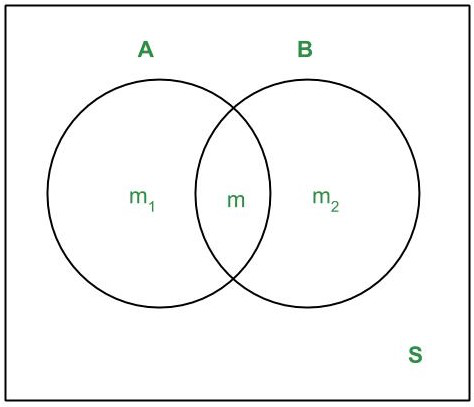概率是指事件发生的程度。当发生诸如扔球,从甲板上摘牌等事件时,则该事件一定是与该事件相关联的概率。在数学上,概率是指期望结果与可能结果总数之比。假设第一个事件已发生,则两个事件A和B同时发生的概率等于另一个事件的概率乘积。这称为概率乘法定理。
定理
定理1:如果A和B是与随机实验相关的两个事件,则
如果P(A)≠0,则P(A∩B)= P(A)P(B / A)
或者,如果P(B)≠0,则P(A∩B)= P(B)P(A / B)
证明:
Let S be the sample space associated with the given random experiment. Suppose S contains n elementary events. Let m1,m2 and m be the number of elementary events favorable to A,B and A ∩ B respectively, Then,
P(A) = m1/n, P(B) = m2/n and P(A∩B) = m/n
Since m1 elementary events are favorable to A out of which m are favorable to B. Therefore, P(B/A) = m/m1. Similarly, we have P(A/B) = m/m2.

Now, P(A ∩ B) = m/n
or, P(A ∩ B) = m/m1 × m1/n = P(B/A) × P(A) … (i)
Again, P(A ∩ B) = m/n
or, P(A ∩ B) = m/m2 × m2/n = P(A/B) × P(B) …(ii)
Note 1:
From (i) and (ii) in the above theorem, we obtain that
P(B/A) = P(A ∩ B)/P(A) and P(A/B) = P(A ∩ B)/P(B)
证明:对于P(B)> 0,P(A / B)≤P(A)
Proof:
n( A ∩ B) ≤ n(A) and n(B) ≤ n(S)
Dividing, we get n( A ∩ B) / n(B) ≤ n(A)/ n(S)
=> P(A/B) ≤ P(A)
Note 2:
(i) The conditional probability P(A/B) is not defined if P(B) = 0.
(ii) P(B / B) = 1
备注:如果A和B是独立事件,则
P(A/B) = P(A) and P(B/A) = P(B)
∴ P(A ∩ B) = P(A) P(B)
定理2:(乘法定理的扩展)。如果A 1 ,A 2 ,…,A n是与随机实验相关的n个事件,则
P(A 1∩A 2∩…∩A N)= P(A 1)P(A 2 / A 1)P(A 3 / A 1∩A 2)…×P(A N / A 1∩A 2 n…A n-1 )
其中,P(A I / A 1∩A 2∩…∩A I-1)表示事件A i的出现的条件概率,考虑到事件A 1,A 2,…,A I-1已经发生。
Particular Case: If A, B, C are three events associated with a random experiment, then
P(A ∩ B ∩ C) = P(A) P(B/A) P(C/A ∩ B)
定理3 :(独立事件的概率乘法定理)如果A和B是两个具有正概率(P(A)≠0,P(B)≠0)的事件,则当且仅当A和B独立
P(A∩B)= P(A)。 P(B)
证明:
We have: P(A ∩ B) = P(A) P(B/A) = P(B) P(A/B); P(A) ≠ 0 . . . (i)
If A and B are independent, i.e A is independent of B and B is independent of A, then, we have
P(A/B) = P(A) and P(B/A) = P(B) . . . (ii)
From (i) and (ii), we get: P(A ∩ B) = P(A) P(B), as required.
例子
例1:如果在第一次抽签后没有替换抽签的纸牌,请找出从连续洗净的纸包中连续两次抽签中抽出钻石纸牌的概率?
解决方案:
Let A be the event of drawing a diamond card in the first draw and B be the event of drawing a diamond card in the second draw. Then,
P(A) = 13C1 / 52 C1 = 13/52 = 1/4
After drawing a diamond card in the first draw 51 cards are left out of which 12 cards are diamond cards.
∴ P(B/A) = Probability of drawing a diamond card in the second draw when a diamond card has already been drawn in the first draw
P(B/A) = 12C1 / 51C1 = 12/51 = 4/17
Required probability = P(A ∩ B) = P(A) P(B/A) = 1/4 × 4/17 = 1/17
示例2:一个袋子中包含19张票,编号从1到19。先抽出一张票,然后再抽出另一张无需更换的票。找出两张票证均显示偶数的可能性。
解决方案:
Let A be the event of drawing an even numbered ticket in the first draw and B be the event of drawing an even numbered ticket in the second draw. Then,
Required probability = P(A ∩ B) = P(A) P(B/A) … (i)
Since there are 19 tickets, numbered 1 to 19, in the bag out of which 9 are even numbered viz. 2, 4, 6, 8, 10, 12, 14, 16, 18.
∴ P(A) = 9/19
Since the ticket drawn in the first draw is not replaced, therefore second ticket drawn is from the remaining 18 tickets, out of which 8 are even numbered.
∴ P(B/A) = 8/18 = 4/9
Substituting these values in (i), we get
Required probability = P(A ∩ B) = P(A) P(B/A) = 9/19 × 4/9 = 4/19
示例3:对40岁的妻子到8岁的丈夫是8:5,而对50岁的丈夫到80岁的丈夫是4:3。
(i)双方都还活着,
(ii)没有人会活着,
(iii)只有妻子会活着,
(iv)只有丈夫会活着
解决方案:
Let us define the events:
A: Wife will be alive,
B: Husband will be alive
Then, we are given:
P(A) = 5/(8 + 5) = 5/13 => P(A’) = 1 – P(A) = 8/13
P(B) = 3/(4 + 3) = 3/7 => P(B’) = 1 – P(B) = 4/7
If we assume that A and B are independent so that A and B’, A’ and B’ are also independent , then the required probabilities are given by:
(i) P(A ∩ B) = P(A)P(B) = (5/13) × (3/7) = 15/91
(ii) P(A’ ∩ B’) = P(A’)P(B’) = (8/13) × (4/7) = 32/91
(iii) P(A ∩ B’) = P(A) – P(A ∩ B) = (5/13) – (15/91) = 20/91
(iv) P(A’ ∩ B) = P(B) – P(A ∩ B) = (3/7) – (15/91) = 24/91